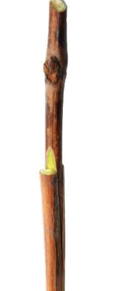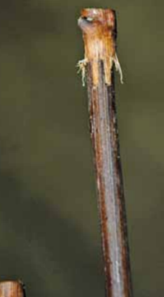The grafted vine is a seedling that is grafted off-site during the dormancy period. This is the most common method at the moment because it is the cheapest and fastest. There are many forms of grafting. Some are mechanized, others are manual. Grafting the vine off-site ensures a faster return to production than grafting on-site. It is also a considerable way to save both time and money compared to a grafting technique in the field.
1.4.4.a Grafted vines
What are possible grafting methods?
There are different forms of vine grafts. Some can be mechanized, others must be done manually. The most widespread at the moment is the Omega graft because it is easiest to implement. To ensure grafting quality, precision is crucial and this means that the diameters of the graft and the rootstock must be identical. If not, the graft will weaken the vine, which loses strength and longevity. Indeed, dead wood can form and this encourages the development of saprophytic fungi, which are responsible for Esca. Here are some examples of grafting techniques:
- English Graft or Whip and Tongue Graft
A cut shaped like a bolt of lightning, sometimes referred to as the Jupiter line graft. This method is presumed more efficient than the Omega graft because it allows an optimal contact zone between the graft and the rootstock. Some nurseries are offering this type of grafting anew, but it comes with an additional cost because the method cannot be fully mechanized, only manual or semi-mechanical.
- Cleft Graft
The cleft graft is the easiest and most common manual grafting technique. The diamenters of each bit of wood must be nearly-identical for it to be effective. When it is well done, there are very few necrosis sites. It is therefore quite qualitative. This technique has lately gained interest from many nurseries. The results are very promising in the fight against Esca as the handler must use identical diameters to obtain the best results.
- Graft-Mortise
The mortise graft is quite an old technique (1920), it has since been somewhat overlooked since the Omega graft gained popularity. The mortise graft provides a larger surface area than the Omega graft, and it has just been developed mechanically which will make it economically affordable in the near short term.
The criteria for choosing the type of graft are related to cost and the relative need to prevent Esca. Since there is a need for much more research regarding the link between graft type and Esca, the choice often depends on human factors and work ethos.




